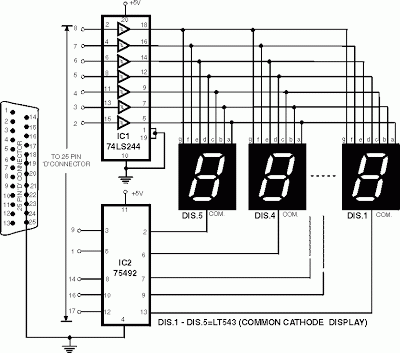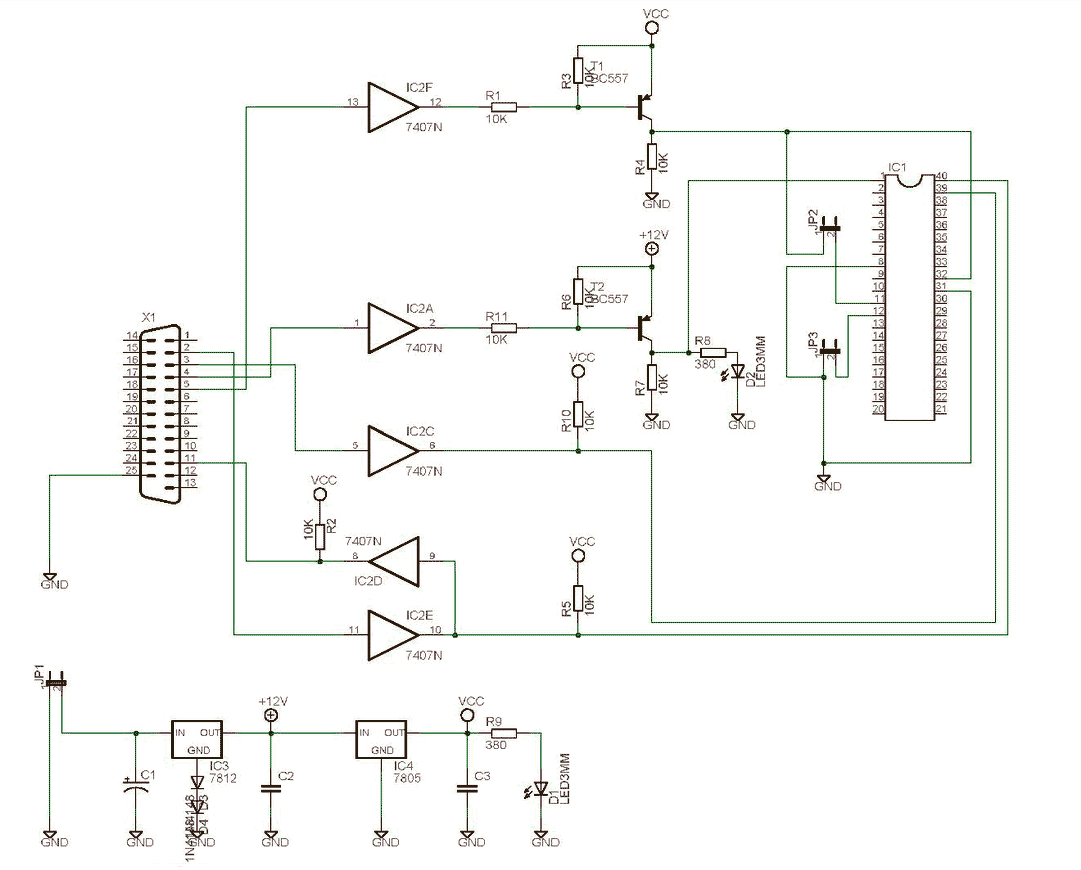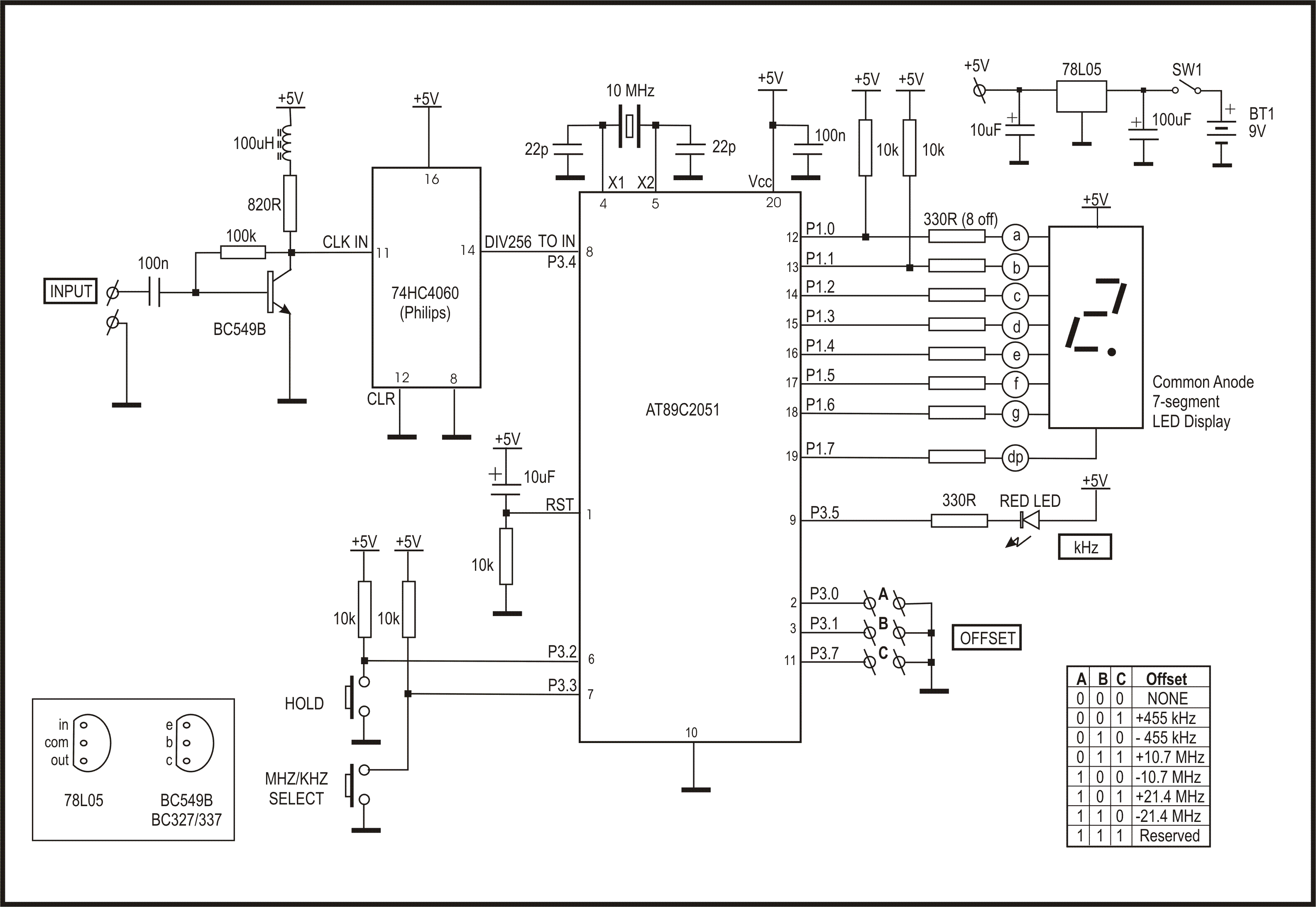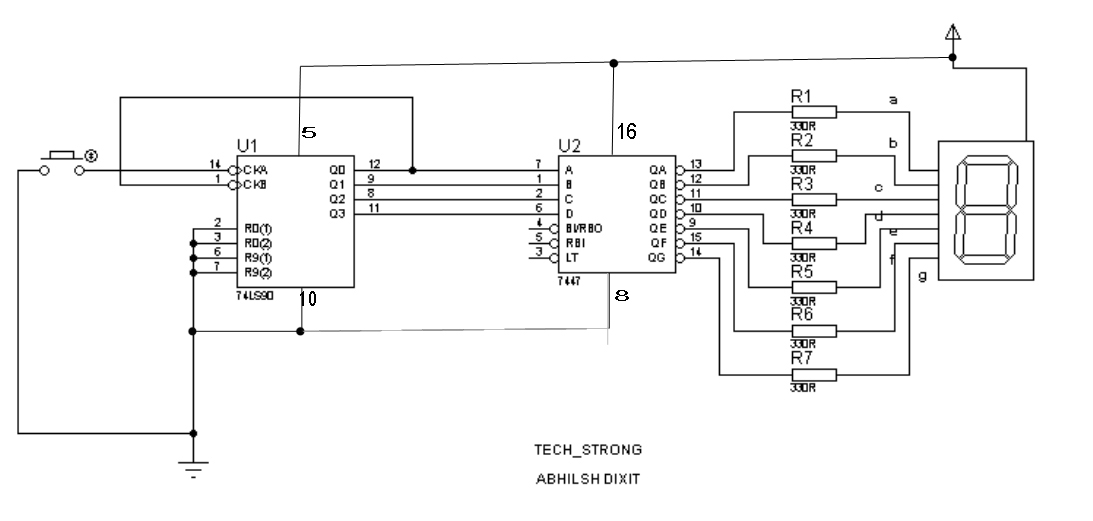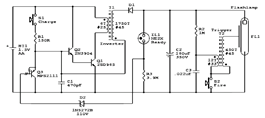
ISP Programmer
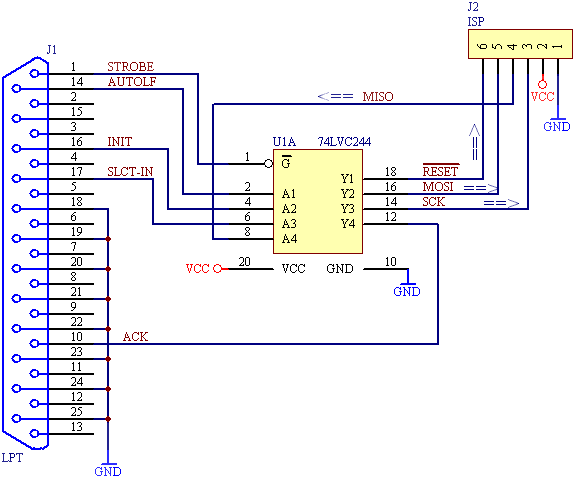
ISP Programmer. Please purchase USB programming cables and start using AVR Studio, avrdude, etc. The source code is now considered abandonware and will remain on Sourceforge indefinitely. This software supports programming of Atmel microcontrollers, including 89Sxx (51), ATtiny, ATmega, and 90Sxx (AVR). It can erase built-in Flash and EEPROM memories as well as read and program them. The ISP Programmer also supports serial Atmel DataFlash memories. Communication with devices occurs serially in-system (ISP - In-System Programming) without needing to remove the chip from the socket or desolder it. The microcontroller to be programmed must be connected to the printer port (LPT) of the computer (directly with wires, without the STROBE signal), according to this list: Microcontroller LPT port signal pin number [STROBE] - STROBE 1, RESET - AUTOLF 14, MOSI - INIT 16, SCK - SLCT-IN 17, MISO - ACK 10, GND - GND 25. The STROBE signal connected to pin 1 of the LPT port is used to control the enabling of 3-state buffers of the programming serial bus (SCK, MISO, MOSI). Its use is optional. However, if connecting the LPT port directly to microcontroller pins, the same logic levels (ground / 5V) as the LPT port in the host should be used, and it must be verified that programming does not disrupt the normal operation of the peripherals connected to this microcontroller. For example, programming signals should not be connected to the enable pin of the LCD. With the ISP Programmer, any programming cable pinout can be utilized, including AT-Prog, SI-Prog, UISP, STK200/300, and AEC ISP. Any pins of the LPT port may be chosen for programming signals, and an arbitrary RESET signal level can be defined. Supported microcontrollers include AT90S1200, AT90S2313, AT90S2323, AT90S2333, AT90S2343, AT90S4414, AT90S4433, AT90S4434, AT90S8515, AT90S8535, AT90CAN32, AT90CAN64, AT90CAN128, AT90PWM2, AT90PWM3, AT90USB646, AT90USB647, AT90USB82, AT90USB162, AT90USB1286, AT90USB1287, ATmega48, ATmega48P, ATmega8, ATmega88, ATmega88P, ATmega8515, ATmega8535, ATmega16, ATmega161, ATmega162, ATmega163, ATmega164P, ATmega165P, ATmega168, ATmega168P, ATmega169, ATmega32, ATmega323, ATmega324P, ATmega325, ATmega328P, ATmega329, ATmega64, ATmega128, ATmega640, ATmega644, ATmega644P, ATmega645, ATmega649, ATmega1280, ATmega1281, ATmega1284P, ATmega2560, ATmega2561, ATmega3250, ATmega3290, ATmega6450, ATmega6490, AT45DB011B, AT45DB011D, AT45DB021B, AT45DB021D, AT45DB041B, AT45DB041D, AT45DB081B, AT45DB081D, AT45DB161B, AT45DB161D, AT45DB321B, AT45DB321C, AT45DB321D, AT45DB642D, AT45CS1282.
The ISP Programmer is a versatile tool designed for programming a wide variety of Atmel microcontrollers and DataFlash memories. The programming process utilizes the In-System Programming (ISP) method, which allows for the programming and debugging of microcontrollers without the need to remove them from their circuit board. This capability is particularly beneficial for embedded systems where physical access to the microcontroller may be limited.
To establish communication with the microcontroller, a direct connection to the LPT port of the computer is required. The LPT port serves as the interface through which programming signals are sent. The pin assignments for the LPT port are critical, as they dictate how the programmer communicates with the microcontroller. The programmer can utilize any pin configuration, allowing for flexibility in design and implementation.
The optional STROBE signal can be used to control the enabling of 3-state buffers within the programming serial bus. Although optional, its inclusion can enhance signal integrity during programming. It is essential to ensure that the logic levels between the LPT port and the microcontroller are compatible to prevent damage to the components or disruption of normal operations.
The ISP Programmer supports a wide range of microcontrollers, including various models within the AT90 and ATmega series. This extensive compatibility makes it a valuable tool for developers working on projects that involve different microcontroller architectures. Additionally, the ability to define custom pinouts and RESET signal levels provides further customization for specific application needs.
In summary, the ISP Programmer is a robust solution for programming Atmel microcontrollers and DataFlash memories. Its ability to operate in-system, combined with its flexible pin configuration and extensive compatibility, makes it an essential tool for engineers and developers in the field of electronics.ISP Programmer Please buy USB programming cables at last and start using AVR Studio, avrdude etc. The source code is now abandonware and it will stay on Sourceforge for ages. This software supports programming of Atmel microcontrollers 89Sxx (`51), ATtiny, ATmega and 90Sxx (AVR). It can erase built-in Flash and EEPROM me mories as well as read and program them. ISP Programmer also supports serial Atmel DataFlash memories. Communication with devices is made serially in system (ISP - In-System Programming) without the need to pull the chip out of the socket or desolder it. The microcontroller you want to program needs to be connected to the printer port (LPT) of the computer (directly with wires, without STROBE signal), according to this list: Microcontroller LPT port LPT port signal signal pin number [STROBE] - STROBE 1 RESET - AUTOLF 14 MOSI - INIT 16 SCK - SLCT-IN 17 MISO - ACK 10 GND - GND 25 STROBE signal connected to pin 1 of LPT port is used to control enabling of 3-state buffers of programming serial bus (SCK, MISO, MOSI).
Using it is optional. But in case of connecting LPT port directly to microcontroller pins, you should use the same logic levels (ground / 5V) as LPT port in host and verify that programming would not brake the normal operation of the peripherials connected to this microcontroller. For example programming signals should not be connected to the enable pin of the LCD. With the ISP Programmer you are able to use any programming cable pinout, including AT-Prog, SI-Prog, UISP, STK200/300 and AEC ISP.
You can choose any pins of the LPT port for programming signals, as well as define arbitrary RESET signal level. AT90S1200, AT90S2313, AT90S2323, AT90S2333, AT90S2343, AT90S4414, AT90S4433, AT90S4434, AT90S8515, AT90S8535, AT90CAN32, AT90CAN64, AT90CAN128, AT90PWM2, AT90PWM3, AT90USB646, AT90USB647, AT90USB82, AT90USB162, AT90USB1286, AT90USB1287 ATmega48, ATmega48P, ATmega8, ATmega88, ATmega88P, ATmega8515, ATmega8535, ATmega16, ATmega161, ATmega162, ATmega163, ATmega164P, ATmega165P, ATmega168, ATmega168P, ATmega169, ATmega32, ATmega323, ATmega324P, ATmega325, ATmega328P, ATmega329, ATmega64, ATmega128, ATmega640, ATmega644, ATmega644P, ATmega645, ATmega649, ATmega1280, ATmega1281, ATmega1284P, ATmega2560, ATmega2561, ATmega3250, ATmega3290, ATmega6450, ATmega6490 AT45DB011B, AT45DB011D, AT45DB021B, AT45DB021D, AT45DB041B, AT45DB041D, AT45DB081B, AT45DB081D, AT45DB161B, AT45DB161D, AT45DB321B, AT45DB321C, AT45DB321D, AT45DB642D, AT45CS1282
🔗 External reference
The ISP Programmer is a versatile tool designed for programming a wide variety of Atmel microcontrollers and DataFlash memories. The programming process utilizes the In-System Programming (ISP) method, which allows for the programming and debugging of microcontrollers without the need to remove them from their circuit board. This capability is particularly beneficial for embedded systems where physical access to the microcontroller may be limited.
To establish communication with the microcontroller, a direct connection to the LPT port of the computer is required. The LPT port serves as the interface through which programming signals are sent. The pin assignments for the LPT port are critical, as they dictate how the programmer communicates with the microcontroller. The programmer can utilize any pin configuration, allowing for flexibility in design and implementation.
The optional STROBE signal can be used to control the enabling of 3-state buffers within the programming serial bus. Although optional, its inclusion can enhance signal integrity during programming. It is essential to ensure that the logic levels between the LPT port and the microcontroller are compatible to prevent damage to the components or disruption of normal operations.
The ISP Programmer supports a wide range of microcontrollers, including various models within the AT90 and ATmega series. This extensive compatibility makes it a valuable tool for developers working on projects that involve different microcontroller architectures. Additionally, the ability to define custom pinouts and RESET signal levels provides further customization for specific application needs.
In summary, the ISP Programmer is a robust solution for programming Atmel microcontrollers and DataFlash memories. Its ability to operate in-system, combined with its flexible pin configuration and extensive compatibility, makes it an essential tool for engineers and developers in the field of electronics.ISP Programmer Please buy USB programming cables at last and start using AVR Studio, avrdude etc. The source code is now abandonware and it will stay on Sourceforge for ages. This software supports programming of Atmel microcontrollers 89Sxx (`51), ATtiny, ATmega and 90Sxx (AVR). It can erase built-in Flash and EEPROM me mories as well as read and program them. ISP Programmer also supports serial Atmel DataFlash memories. Communication with devices is made serially in system (ISP - In-System Programming) without the need to pull the chip out of the socket or desolder it. The microcontroller you want to program needs to be connected to the printer port (LPT) of the computer (directly with wires, without STROBE signal), according to this list: Microcontroller LPT port LPT port signal signal pin number [STROBE] - STROBE 1 RESET - AUTOLF 14 MOSI - INIT 16 SCK - SLCT-IN 17 MISO - ACK 10 GND - GND 25 STROBE signal connected to pin 1 of LPT port is used to control enabling of 3-state buffers of programming serial bus (SCK, MISO, MOSI).
Using it is optional. But in case of connecting LPT port directly to microcontroller pins, you should use the same logic levels (ground / 5V) as LPT port in host and verify that programming would not brake the normal operation of the peripherials connected to this microcontroller. For example programming signals should not be connected to the enable pin of the LCD. With the ISP Programmer you are able to use any programming cable pinout, including AT-Prog, SI-Prog, UISP, STK200/300 and AEC ISP.
You can choose any pins of the LPT port for programming signals, as well as define arbitrary RESET signal level. AT90S1200, AT90S2313, AT90S2323, AT90S2333, AT90S2343, AT90S4414, AT90S4433, AT90S4434, AT90S8515, AT90S8535, AT90CAN32, AT90CAN64, AT90CAN128, AT90PWM2, AT90PWM3, AT90USB646, AT90USB647, AT90USB82, AT90USB162, AT90USB1286, AT90USB1287 ATmega48, ATmega48P, ATmega8, ATmega88, ATmega88P, ATmega8515, ATmega8535, ATmega16, ATmega161, ATmega162, ATmega163, ATmega164P, ATmega165P, ATmega168, ATmega168P, ATmega169, ATmega32, ATmega323, ATmega324P, ATmega325, ATmega328P, ATmega329, ATmega64, ATmega128, ATmega640, ATmega644, ATmega644P, ATmega645, ATmega649, ATmega1280, ATmega1281, ATmega1284P, ATmega2560, ATmega2561, ATmega3250, ATmega3290, ATmega6450, ATmega6490 AT45DB011B, AT45DB011D, AT45DB021B, AT45DB021D, AT45DB041B, AT45DB041D, AT45DB081B, AT45DB081D, AT45DB161B, AT45DB161D, AT45DB321B, AT45DB321C, AT45DB321D, AT45DB642D, AT45CS1282
🔗 External reference
